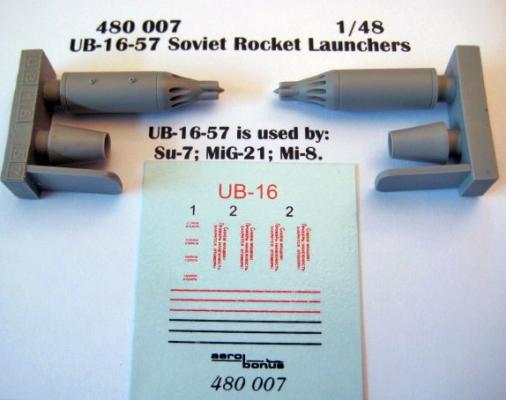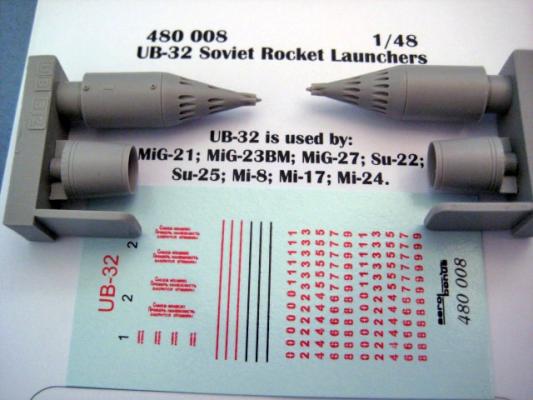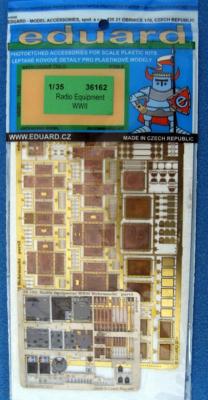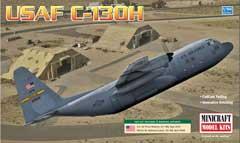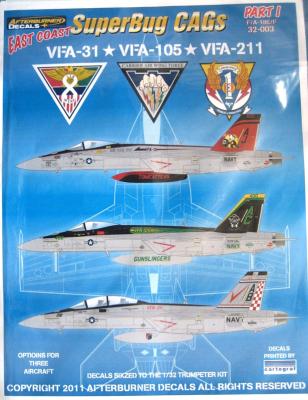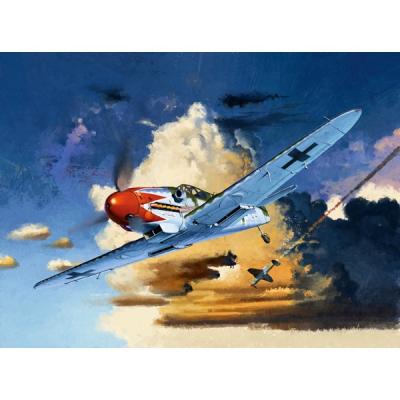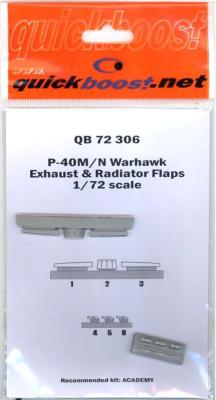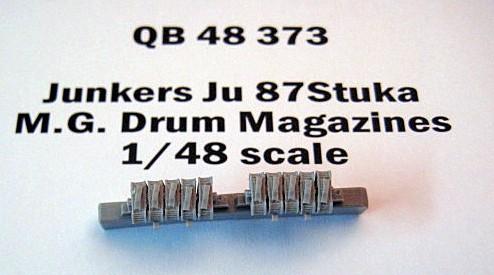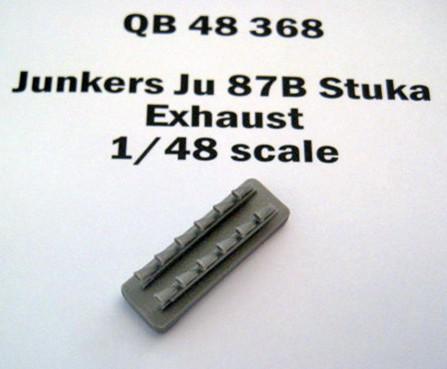In the post war years of the 1940s The U.S. Navy wanted a new missions aircraft to replace the AF2 and secure a single platform aircraft. The Grumman “iron works” aircraft company always catering to the needs of the Navy introduced the G-89 a twin-engine high wing prototype. The prototype was all navy she featured folding wings, large payload capacity, searchlights and a tail-hook. Also a magnetic anomaly detector boom and a retractable belly search radar. The first prototype ‘XS2F-1’ flew on December 4th1952. Entering service in 1954 the S-2s were the first single ship aircraft to carry out anti-submarine warfare (ASW) which previously required 2 aircraft. The Trackers and her cousins served faithfully during the cold war keeping track of Russian submarines for many years by 1976 over 1,000 Trackers have been retired from the Navy.
What's New
Aerobonus is a new sub-division of Aires that seems to concentrate on the armament of former Soviet Union aircraft. This set contains two rocket pods cast in light grey resin that are perfectly formed with no blemishes or bubbles anywhere. The rocket pods are easy enough to assemble as there are only two pieces to each pod, the front and aerodynamic rear fairing.
Also included are decals for the stenciling and alignment of the sections. The decals are nicely printed and are easy enough to add.
The modeler just needs to add pins to the holes in the mounting lugs and drill a corresponding hole in the model. Painting is easy enough, aluminum with steel for the tubes.
This type of rocket pod was used on the Su-7, Mig-21 and the Mi-8. So you can update your OEM Su-7 or Eduard or Academy Mig-21 or the Hobby Boss Mi-8.
Simple and very effective. You can now change the armament on your Soviet built aircraft without having to rob another kit.
Aerobonus’ latest release is the ‘big’ rocket pod used on a variety of aircraft. For me this rocket pod usually mounted on the Mi-24 Hind helicopter. It was also used on the Mig-21, Mig-23, Mig-27, and Mi-8/17.
Perfectly cast in light grey resin, with no bubbles or imperfections, these rocket pods are beautiful. The tip and the openings are beautiful renderings. The pods are cast in two pieces, the nose cone/center section and the exhaust fairings. Cutting them off and attaching them is easy enough.
Decals are provided for the stencils, alignment marks and the serial number on the side of the pods. The instructions show where they would go.
Painting them is easy, aluminum. Attaching them is easy enough just add pins in the mount lugs and then attach them to the model.
Eduard has put together a bunch of German Radios in 1/35 scale which are very detailed, right down to the tiniest handles and each radio can be made to sit alone as is or have straps supplied to each unit so that it can be attached to a figure to make the figure appear to be actually carrying the radio. Small headphones which attach to each radio by a wire (which you will have to supply) add even more realism. Eduard has painted them in such a way as to depict them as being “well handled”. The detail is so precise and clear which meets their usual standards. There are nine radios all together (some are doubles) and each one is better than the next. Everything is included to make different variations on each one, so the variations are limitless.
The Aircraft
If you’ve never seen a C-130, and never had a ride in a Herk, you’ve probably been living under a rock somewhere. There are more than 40 variants, serving in 60 countries. The C-130 has been in service with the US Air Force for over 50 years, albeit with several different models and many improvements along the way.
The company, Afterburners Decals, deals with mostly 1/48 decals and has many different sets of which most are of the newer and modern jets, although there are a few sets which contain decals for weapons and missiles. There are only three sets of decals in the 1/32 scale. In the past there weren’t many modelers building in 1/32 scale so the demand for decals in this scale wasn’t large enough to justify the need to produce them. But now, since there are many more modelers building kits in the 1/32 scale range, it stands to reason that the amount of kits sold in that scale are increasing as well, so Afterburner Decals have decided to try supplying the large scale decals again. If this works out, Afterburner will be making more sets for the large scale builders.
The Kit
Academy provides you with six sprues of light grey plastic and two small clear plastic. The sprues are the same ones that were issued by Hobbycraft, but there is a difference. The difference is the inclusion of three additional items, two cowl guns and a pitot tube made out of turned brass. These items are little gems of work. The guns have hollowed out ends and look perfect. The decals are printed by Cartograf and provide markings for one colorful aircraft. Being from Cartograf they are in perfect register and suitably thin. In essence, perfect decals.
The instructions are easy enough to understand and broken down into twelve steps. The marking option provides a four view drawing that will help you mark your airplane.
Quickboost’s line of after market exhaust options just keeps on growing. The latest addition is for the Academy P-40. It is up to their usual standards; molded in a cream colored resin, smooth, seamless and bubble free. One thing of note is that they are really easy to remove from the mold block with just a few passes of the hobby saw. Another plus is that the exhausts are bored out, which would be a real pain if you tried to do it on the kit part. One thing I’ve noticed about Quickboost is that you’re not able to tell very easily if the after market part is for the kit on the label or a conversion part to change another kit to the one stated on their package. I believe this is the case here.
There are limitations to plastic molding that resin doesn’t have to worry about. Such is the case of the Italeri MG Magazine Drums. The kit items are nice but they lack the subtle detail on the sides and the handles. Well Quickboost recognized this and has provided us with two sets of magazines. The magazines have the detail perfectly rendered.
Perfectly molded in light grey resin these parts are simple to add to the kit. The detail parts will dress up the interior of the Stuka in an easy and effective way.
Highly recommended
Thanks to Aires and IPMS/USA for the review copy. You can obtain your copy at www.quickboost.net or through your local hobby shop or online retailer. Let them know we sent you.
The new Italeri Ju-87 Stuka is a great example of this airplane. The exhausts are like most kit exhausts molded solid. I can’t thin the ends out to save my life. Thank God for Quickboost.
The exhausts are molded in light grey resin with realistic weld lines and hollowed out ends. These exhausts are typical of all of Quickboost exhausts in that they are drop in replacements for the kit item so they are no more difficult to deal with than the kit item. Simply remove, paint and weather and install.
Highly recommended
Thanks to Aires and IPMS/USA for the review copy. You can obtain your copy at www.quickboost.net or through your local hobby shop or online retailer. Let them know we sent you.

